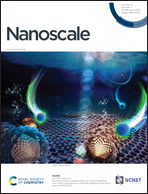Complex-decorated surfactant-encapsulated clusters (CD-SECs) as novel multidynamic hybrid materials†
Abstract
Generation of well-defined organic–inorganic hybrid materials with controllable size and morphology is challenging and an active area of modern research in view of their unique properties and thus multifunctional applications. Specifically polyoxometalates (POMs) were recognized as a very promising group for the construction of those systems, nonetheless there are domains where the profound understanding of hierarchical mutual interactions and assembly are lacking. We present an efficient approach towards the synthesis of a novel group of POM-based nanocomposites that we name Complex-Decorated Surfactant Encapsulated-Clusters (CD-SECs). In the investigated system the organic surfactant may behave as a metal-coordinating agent, thus allowing for derivatization of the synthesized SECs via utilization of the non-covalent interactions. We demonstrate possibilities and limitations of three types of hybrid systems (H1–H3) generated via seven distinct constructing approaches (routes A–G). These systems have the potential to exhibit multiresponsive functions depending on the nature of their building blocks and could find many potential applications in biology or materials science.



 Please wait while we load your content...
Please wait while we load your content...